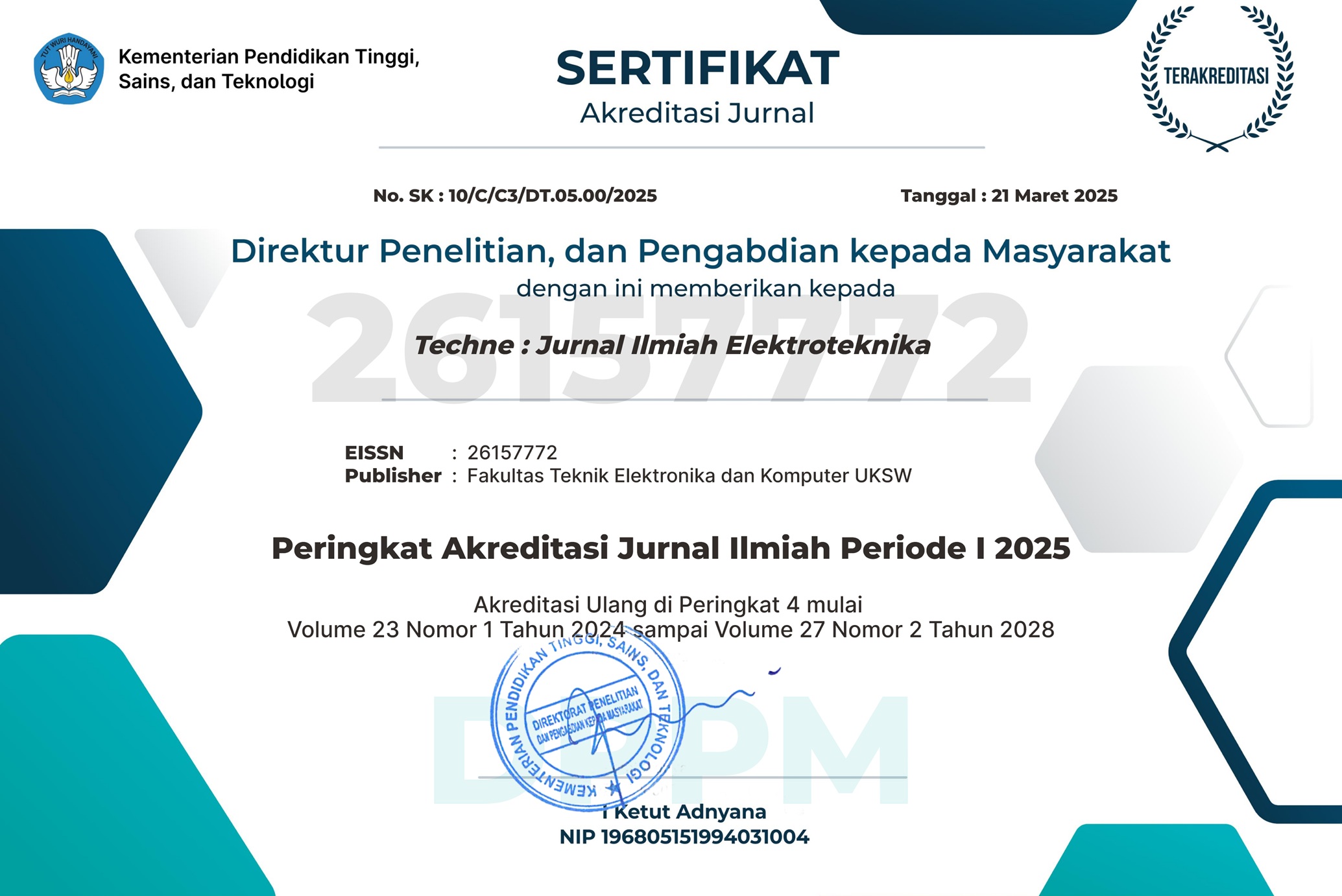Rancang Bangun Sistem Kamera Pengawas dengan Pengenalan Wajah untuk Keamanan Berbasis Blynk Legacy
DOI:
https://doi.org/10.31358/techne.v22i2.381Keywords:
ESP32-CAM, camera, face recognition, intruderAbstract
Covid-19 pandemic that has occurred since the beginning of 2020 has brought down all aspects of the country, starting from community activities to the economy. This has an impact on increasing the number of crimes committed by the community such as theft, robbery or other crimes. In this study, a room security system is proposed that uses a surveillance camera with a face recognition ability that records the face image of an intruder and records events as evidence of an intrusion. This system sends information quickly and automatically to the Android application user if an intruder who the camera doesn't recognize enters his house. The smartphone application user can control camera movements inside the house to monitor the movement of intruders and record the incident. This system uses 5 ESP32-CAM cameras. One camera is used to recognize and record the intruder's face image placed in front of the house and four cameras as surveillance and face recognition cameras are placed inside of the house. Each camera is driven by a servo motor controlled by a ESP8266 microcontroller. From the test results it is known that the maximum distance that the cameras still recognize the face image of an intruder or the home owner's face image is 2 meters when the light is bright. When it is dim, the camera in front of the house recognizes the face images up to 0.5 meters while the cameras inside of the house recognize the face images up to 1 meter. The average delay time for sending data from the camera system to application user is 201 ms to 617 ms.
Downloads
References
Daftar Pustaka
BS. Wardhana, “Kompleksitas Tugas Kepolisian pada Masa Pandemi Covid-19,” Jurnal Ilmu Kepolisian, vol. 14, no. 2, h. 80 - 88, 2020.
J. Aperdanaste1, A. Hasanah A, AYM. Siregar, “Pengaruh Pembatasan Sosial dan Variabel Ekonomi Terhadap Prevalensi Pandemi Covid-19 di Provinsi Jawa Barat (Dalam Perspektif Kriminologi Dan Viktimologi),” Jurnal Ekonomi Kesehatan Indonesia, vol. 6, no. 2, h. 95 - 110, 2021.
N. Atikah N. and dkk, “Sistem Image Capturing Menggunakan ESP32-Cam Untuk Memonitoring Objek Melalui Telegram,” Jurnal Ilmiah Manajemen Infromatika dan Komputer (KOPERTIP), vol. 6, no. 2, h. 49 – 53, 2022.
APM. Susilo, D. Darlis, DA. Nurmantris, “Pengenalan Wajah Berbasis Esp32-Cam Untuk Sistem Kunci Sepeda Motor,” Jurnal Elektro dan Telekomunikasi Terapan, vol. 8, no. 2, h. 1091 – 1103, 2021.
A. Indraprasti, Windarto, “Aplikasi Kontrol Keamanan Ruang Menggunakan Mikrokontroler Atmega328, Sensor Pir Dan Webcam Berbasis Android Pada Roofkop Café,” Sistem Komputer dan Teknik Informatika (SKANIKA), vol. 1, no. 3, h. 1086 – 1092, 2018.
A. Ramschi A. J. Makal, R. Katuuk, V. Ponggawa, “Peran Strategis IPTEK dan Bisnis sebagai Modal Investasi Pembangunan Nasional Pasca Pandemi Covid-19: Pemanfaatan ESP32 Pada Sistem Keamanan Rumah Tinggal Berbasis IoT,” in Industrial Research Workshop and National Seminar (IRWNS). Bandung Indonesia 2021.
E. Wibisono, RP. Astutik, YA. Surya, “Rancang Bangun Sistem Keamanan Rumah Melalui Pengenalan Wajah Menggunakan Metode LBP (Local Binary Pattern) Berbasis Raspberry Pi dan Telegram,” Jurnal Power Elektronik (POLEKTRO), vol. 11, no. 1, h. 21 – 25, 2022.
Handsontec, ESP32-CAM WiFi + Bluetooth + Camera Module, Datasheet [Online], https://www.handsontec.com/dataspecs/module/ESP32-CAM.pdf, diakses tanggal 20 Maret 2022.
A. Satriadi, Wahyudi dan Christiyono, “Perancangan Home Automation Berbasis NodeMCU,” Transient, vol. 8, no. 1, h. 64 – 71, Maret 2019.
A. M. Alfazri, Awaliyah Tjut, and Negara Teguh Puja, “Prototipe Sistem Pintu Otomatis Keamanan Ruangan Menggunakan Sensor Pir Dan Sensor Limit Swicth Berbasis Mikrokontroller,” Jurnal PROSISKO, vol. 7, no. 1, pp. 1–16, Dec. 2017.
N. M. Raharja, M. A. Fathansyah, and A. N. N. Chamim, “Vehicle Parking Security System with Face Recognition Detection Based on Eigenface Algorithm,” Journal of Robotics and Control (JRC), vol. 3, no. 1, h. 78 – 85, Jan 2022.
M. R. Muliawan, B. Irawan, dan Y. Brianorman, “Implementasi Pengenalan Wajah dengan Metode Eigenface pada Sistem Absensi,” Jurnal Coding, vol. 03, no. 1, pp 41-50, 2015.
Alfaizun, Mahyuddin, dan Sanusi, “Sistem Pengenalan Citra Wajah Menggunakan Metode Eigenface dengan Visual Studio,” Jurnal Teknologi Informasi, vol. 1, no. 1, pp1-8, Mei 2022.
D. I. Bramantio, E. Susanto, R. Nugraha, “Perancangan dan Implementasi Keamanan Pintu Berbasis Pengenalan Wajah dengan Metode Eigenface,” e-Proceeding of engineering, vol. 3, no. 1, pp 79, April 2016.
A, Jamhari, F. M. Wibowo, dan W. A. Saputra, “Perancangan Sistem Pengenalan Wajah Secara Real Time pada CCTV dengan Metode Eigenface,” Journal of Informatics, Information System, Software Engineering and Applications, vol. 2, no. 2, pp 20-32, May 2020.
Downloads
Published
How to Cite
Issue
Section
License
Copyright (c) 2023 Chandra I. Zamorano, Kiki Prawiroredjo, E. Shintadewi Julian, Endang Djuana

This work is licensed under a Creative Commons Attribution-NonCommercial-ShareAlike 4.0 International License.








